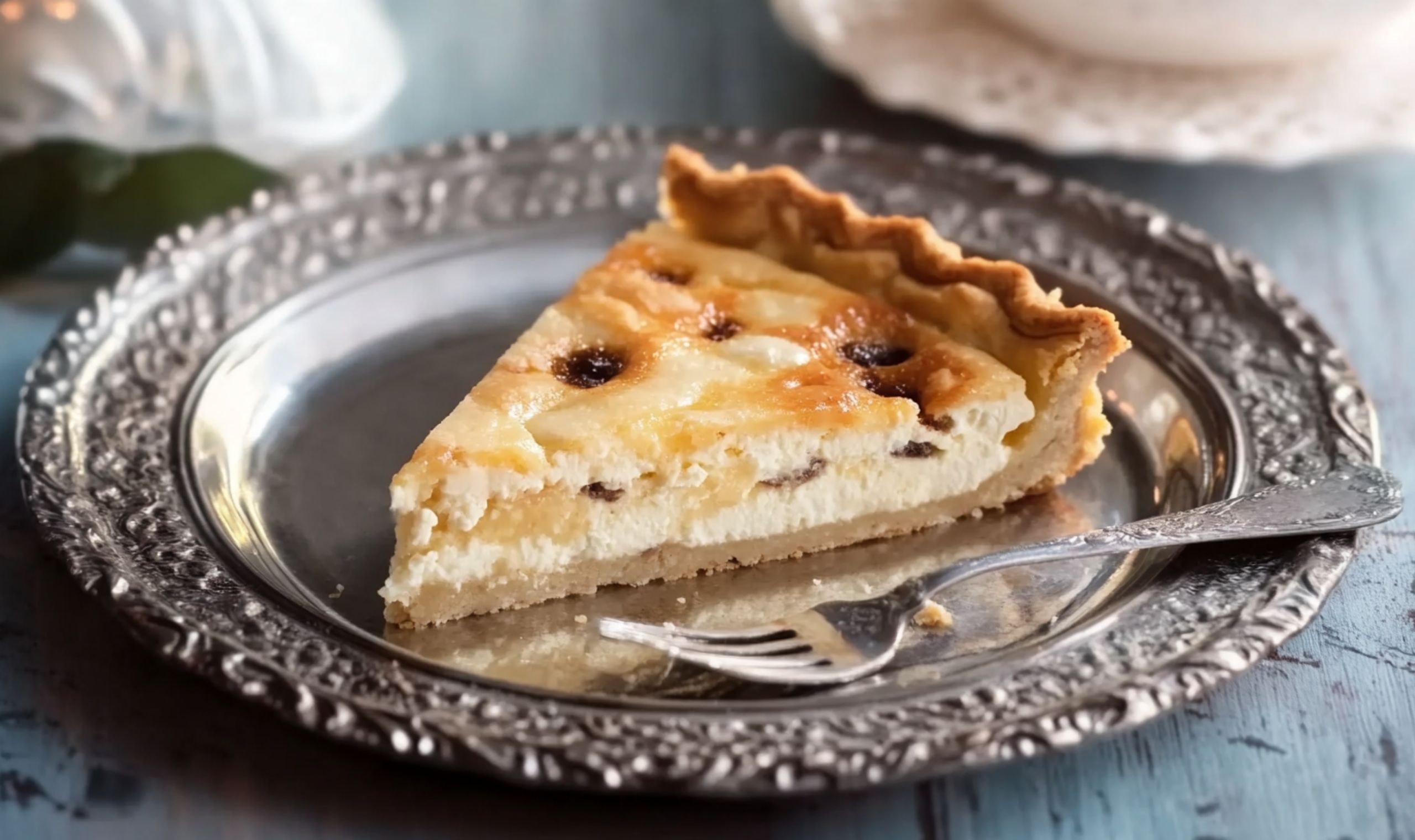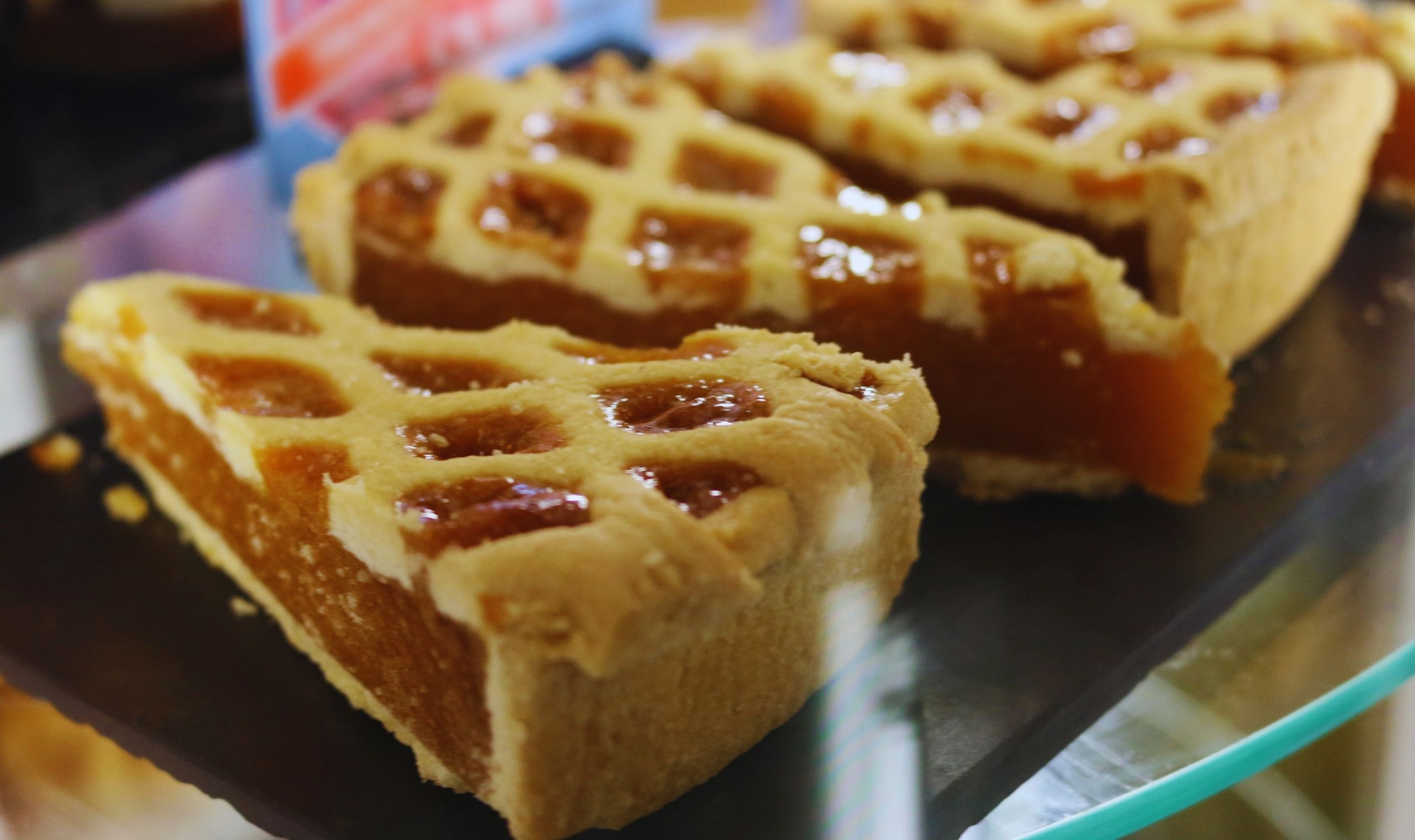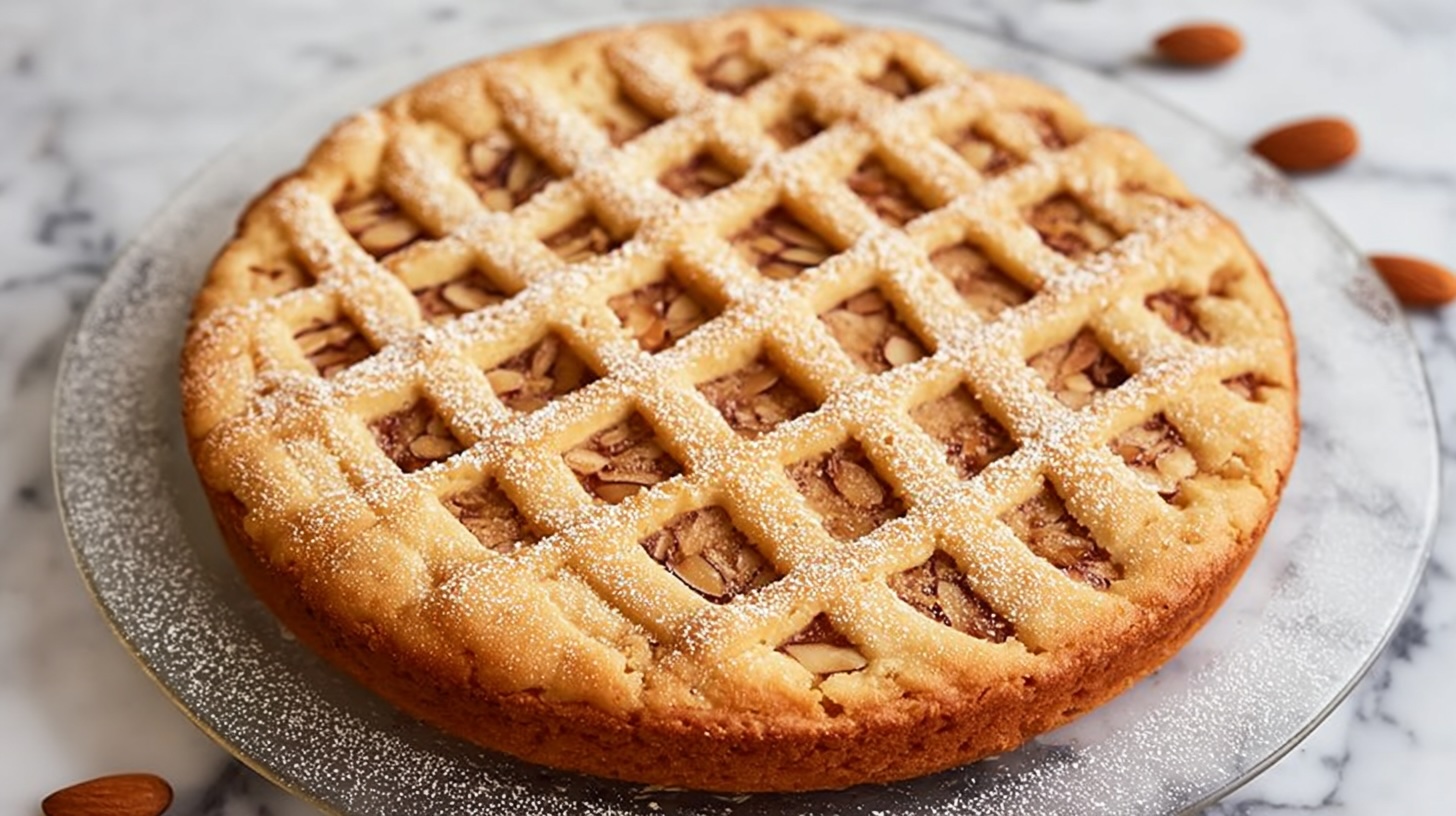Crostata di Ricotta
The Essence of Crostata di Ricotta
The crostata di ricotta is a quintessential Italian dessert that embodies richness and texture, making it a favorite among aficionados of sweet pies. The foundation of this delightful dish lies in its primary ingredient: ricotta cheese. This creamy cheese, traditionally made from whey, contributes a smooth and velvety consistency to the filling, setting the stage for a dessert that is both indulgent and surprisingly light. It is the star player of this recipe, providing depth and a nuanced flavor that cannot be replicated by other cheeses.
Alongside ricotta, lemon zest plays a vital role in elevating the taste of the crostata di ricotta. The citrus notes impart refreshing brightness, counterbalancing the creaminess of the ricotta. The zest serves as a reminder of Italy’s sun-kissed landscapes and is instrumental in creating a harmonious blend of flavors. Similarly, a hint of cinnamon is often added, offering a subtle spiciness that enhances the overall complexity of the pie. This fragrant spice complements the sweetness of the ricotta filling, creating a warm and inviting aroma that fills the kitchen during preparation.
The pastry crust of the crostata di ricotta, typically made from flour, butter, and sugar, deserves equal attention. This crust, which can either be shortcrust or a more flaky variant, provides a contrasting texture to the creamy filling. The interplay between the buttery, golden crust and the rich ricotta filling is a hallmark of this beloved Italian cheesecake. When baked to perfection, it should have a delightful crispness while maintaining enough structure to hold the filling without becoming soggy.
Each ingredient in the crostata di ricotta plays an essential role, creating a dessert that is not only visually appealing but also a testament to the richness of Italian culinary tradition. The combination of creamy ricotta, zesty lemon, aromatic cinnamon, and a perfectly baked crust all culminates in an unforgettable dessert that continues to captivate palates around the world.
Historical Roots of Crostata di Ricotta
The crostata di ricotta is a traditional Italian dessert that showcases the rich culinary heritage of Italy. Its roots can be traced back to ancient times, with variations of cheese tart being crafted by various civilizations that occupied the Italian peninsula. Cheese, often made from sheep’s or cow’s milk, has long been a staple in Italian cuisine, and ricotta, with its creamy texture, became a favored choice for sweet and savory dishes alike.
As Italy evolved, so too did the crostata di ricotta, with each region adding its own unique spin. In Tuscany, for instance, the crostata is often prepared with local ingredients, infused with the flavors of the countryside. Meanwhile, in southern Italy, different fruits are incorporated to enhance the dish, reflecting the abundance of produce in that region. This adaptability has allowed the crostata di ricotta to maintain its relevance among various Italian culinary traditions.
The significance of the crostata di ricotta extends beyond mere culinary enjoyment; it has found its place within social and familial gatherings throughout Italian history. During festive occasions, such as Easter celebrations, families would come together to share this cheesecake delight, passing down recipes from generation to generation. Anecdotes suggest that the process of making crostata was a communal event, fostering connections within families and communities.
Moreover, the crostata di ricotta often represented a symbol of abundance and prosperity, making it a favorable dessert during celebrations and special meals. Its combination of simplicity in preparation and the richness of flavor has contributed to its enduring status as a beloved dish throughout Italy. As time has gone on, this dessert remains a staple, cherished not only for its taste but as a testament to the cultural roots from which it has emerged.
Crostata di Ricotta Varieties Across Italy
The crostata di ricotta, an iconic Italian dessert, showcases remarkable diversity across Italy’s various regions. Each area presents its unique spin on this cheesecake-like delight, utilizing an array of ingredients reflective of local traditions and resources. In northern regions, such as Liguria and Trentino, one may encounter variations that incorporate unique spices and ingredients. For instance, the Ligurian version often features the addition of pine nuts and candied fruit, creating a rich, nutty profile that sets it apart from other interpretations. The crust here might be slightly thicker, offering a hearty foundation.
As we journey southward, the crostata di ricotta adopts fresh elements characteristic of the vibrant southern cuisine. In Sicily, for example, this beloved dessert might be infused with citrus zest, particularly lemon or orange, which brightens the flavor palate. Furthermore, in Apulia, local traditions introduce fresh figs or wild cherries as fillings, offering a contrast to the creamy ricotta. The crust south of Rome tends to be made with a more crumbly pastry that complements the sweet and tangy fillings beautifully.
The preparation methods also vary significantly across regions. In the north, the crostata might be prepared as a layered dessert, while in southern Italy, it is often arranged with a more rustic appearance, showcasing topping variations. These differences not only highlight the regional tastes but also the cultural significance of the crostata di ricotta as it adapts to local ingredients and customs. Such variations are a testament to the rich culinary landscape of Italy, where each family adds its touch, contributing another chapter to the story of this delectable dessert.
Jokes and Fun Facts About Crostata di Ricotta
Crostata di ricotta has not only secured its place as a beloved dessert in Italian cuisine but also provoked a fair amount of humor and fun. With its creamy filling and delectable crust, it is no surprise that this Italian cheesecake has become a fun source of jokes and light-hearted banter among food lovers. For instance, one might find themselves chuckling over the quip, “Why did the crostata di ricotta go to therapy? Because it had too many crust issues!” This playful jibe highlights the expansive array of textures that define this delightful tart, making it relatable to anyone who has faced challenges in their culinary creations.
Another humorous take involves the crostata’s pervasive charm that transcends national boundaries—”What did the crostata di ricotta say to the other pastries? I’m just here to be the cream of the crop!” This funny remark emphasizes how the dessert stands out amongst its counterparts, showcasing a playful rivalry in the world of pastries. Such jokes not only bring laughter but also serve to strengthen the bond among those who appreciate Italian dessert culture.
Moreover, it is fascinating to consider the historical anecdotes surrounding the crostata di ricotta. Originally crafted as a celebratory dish in Italian households, it has evolved into a staple that pervades community celebrations and family gatherings. Often associated with festivity and warmth, it brings people together, much like the laughter shared over a good pun. These small snippets of humor related to this cheesecake delight encapsulate its significance, revealing that crostata di ricotta is not merely a dish, but a vessel of joy and communal bonding.
Classic Recipe for Crostata di Ricotta
The crostata di ricotta is a classic Italian dessert that combines the richness of ricotta cheese with a buttery pastry crust. To prepare this delectable pie at home, you’ll need to gather some essential ingredients and equipment.
For the crust, you will require: 300 grams of all-purpose flour, 150 grams of cold unsalted butter, 100 grams of sugar, 1 large egg, and a pinch of salt. For the filling, you will need: 500 grams of fresh ricotta cheese, 150 grams of sugar, 2 large eggs, 1 teaspoon of vanilla extract, and the zest of one lemon.
Begin by preparing the crust. In a large mixing bowl, combine the flour, sugar, and salt. Cut the cold butter into small cubes and add it to the flour mixture. Using your fingers or a pastry cutter, work the butter into the flour until the mixture resembles coarse crumbs. Add the egg and mix until it forms a dough. Shape the dough into a ball, wrap it in plastic wrap, and refrigerate for at least 30 minutes.
While the dough is chilling, prepare the filling. In another bowl, blend the ricotta cheese with sugar until smooth. Add the eggs, vanilla extract, and lemon zest, mixing well until fully combined. Check the consistency; it should be creamy yet firm enough to hold its shape.
Once the crust has chilled, preheat your oven to 180°C (350°F). Roll out the dough on a floured surface to fit your pie or tart pan. Place the rolled dough into the pan, pressing it into the edges. Pour the ricotta filling into the prepared crust, smoothing the top with a spatula.
Bake the crostata di ricotta in the preheated oven for approximately 40-45 minutes, or until the filling is set and the crust is lightly golden. Allow it to cool before serving, which allows the flavors to meld beautifully, creating a truly authentic Italian cheesecake experience.
Modern Twists on the Traditional Recipe
Crostata di Ricotta has long been cherished as a classic Italian dessert, renowned for its rich, creamy filling and buttery crust. However, culinary innovation has sparked delightful modern adaptations that maintain the essence of this beloved dish while inviting new flavors and dietary preferences. Contemporary interpretations of crostata di ricotta allow both novice and experienced bakers to explore versatility in their kitchens.
One popular adaptation involves the incorporation of different fruits. While traditional recipes often call for fruit preserves, modern variations might showcase seasonal fresh fruits such as strawberries, blueberries, or figs. The vibrant colors and varied textures of these fruits enhance the visual appeal of the crostata while providing contrasting flavors that elevate the overall experience. Consider pairing citrus zest with ricotta filling for a refreshing twist, creating a delightful balance between tangy and creamy.
For those adhering to specific dietary restrictions, gluten-free crostata di ricotta is now within reach. Alternative flours, such as almond or coconut flour, can replace conventional wheat flour to create a light and crumbly crust. Similarly, vegan adaptations have emerged, utilizing plant-based ingredients in the filling. Silken tofu combined with nutritional yeast can simulate the creaminess of ricotta, satisfying both vegan lifestyles and those with dairy allergies.
Experimentation extends beyond just moods and dietary restrictions; it also includes flavor profiles. Infusing the ricotta mixture with ingredients like vanilla bean, lemon curd, or dark chocolate can introduce a gourmet touch to the classic dessert. Utilizing unique toppings, such as crushed nuts or edible flowers, can further transform the crostata di ricotta into a stunning centerpiece for any gathering.
These modern twists demonstrate that the spirit of the crostata di ricotta can be preserved while adapting to contemporary tastes and preferences, encouraging a new generation to embrace this timeless Italian delight.
Crostata di Ricotta in Popular Culture
The crostata di ricotta, an Italian delicacy, has found its way into various facets of popular culture, transcending the boundaries of traditional cuisine to become a symbol of Italian culinary heritage. This sweet tart, often composed of a crumbly pastry crust filled with a rich ricotta mixture, has made appearances in literature, film, and even art, showcasing its enduring appeal and cultural significance.
In literature, the crostata di ricotta is frequently referenced in works that celebrate Italian culture, emphasizing its role in family gatherings and festive occasions. Authors often describe the preparation of this dish as a nostalgic journey, evoking cherished memories associated with cooking and sharing meals with loved ones. Such descriptions not only highlight the dish but also serve to illustrate broader themes of community and tradition, making it a popular choice among writers who seek to convey the essence of Italian life.
Furthermore, films that revolve around Italian culture and cuisine often include scenes featuring crostata di ricotta, typically showcasing family members preparing and enjoying this delightful dessert. These cinematic moments of joy and togetherness elevate the dish’s status, illustrating its importance in Italian heritage. The representation of this cheesecake-like tart in movies tends to evoke a sense of comfort and warmth, resonating with audiences and reinforcing the notion of food as a central element in the bonds between family and friends.
Artists have also embraced the crostata di ricotta, often depicting it in their work as a way to celebrate the simplicity and elegance of Italian desserts. Through paintings and illustrations, artists capture the inviting nature of this dish, utilizing its vibrant colors and textures to evoke emotions and memories associated with Italian culinary traditions. In this manner, the crostata di ricotta not only exists as a tangible food item but also as a piece of art that reflects the richness of Italian culture.
Where to Find Authentic Crostata di Ricotta
For those who wish to indulge in the exquisite flavors of crostata di ricotta without the need to bake, Italy offers numerous establishments renowned for their authentic versions of this beloved dessert. Whether visiting the vibrant streets of Rome or the scenic coastal towns of Amalfi, there are certain bakeries, restaurants, and pastry shops that stand out for their remarkable take on this classic Italian cheesecake.
In Rome, one cannot overlook Panificio Bonci, a bakery acclaimed for its artisanal approach. Their crostata di ricotta, crafted with fresh ingredients and a crumbly crust, is often hailed by locals and visitors alike. Another place to consider is Antico Caffè Greco, which has been serving delicious pastries since 1760. Their traditional take on this dessert is a must-try, as it combines the richness of ricotta cheese with perfectly balanced sweetness.
If you find yourself in Florence, head to Pasticceria Giorgio. This pastry shop not only specializes in crostata di ricotta but also offers a variety of delightful pastries, ensuring that visitors experience authentic Tuscan flavors. Likewise, Pasticceria Caffe Barchi in Naples prepares a unique version, blending local ingredients that reflect the region’s culinary heritage
For those seeking hidden gems, exploring smaller towns can yield surprising discoveries. Many family-run businesses pride themselves on traditional baking techniques, and you might stumble across a local bakery offering a delicious rendition of crostata di ricotta. Always look for establishments that emphasize fresh, high-quality ingredients, as this is essential for enjoying the best the dessert has to offer.
In conclusion, whether you are wandering through historic city centers or exploring quaint villages, the search for authentic crostata di ricotta can lead to memorable culinary experiences. Enjoying this rich dessert in its birthplace is an opportunity to appreciate the timeless tradition and skill that goes into every slice.
Tips for Pairing Crostata di Ricotta
Crostata di ricotta, with its creamy texture and delicate sweetness, can be elevated even further when paired with the right beverages and sides. Selecting complementary flavors is essential to creating a harmonious dining experience. When considering drinks to accompany your crostata, one cannot overlook the appeal of a well-chosen wine or coffee. For those who prefer wine, a light, fruity white such as a Pinot Grigio or a slightly sweet Moscato can enhance the ricotta’s richness without overpowering it. Alternatively, a medium-bodied red wine like Chianti could offer a contrasting flavor profile that works splendidly with the dessert’s sweetness.
If you are inclined towards coffee, an espresso or a cappuccino can provide a perfect balance with crostata di ricotta, particularly after a meal. The strong, rich flavor of coffee complements the creamy cheesecake-like filling, enhancing the dessert’s overall appeal. Incorporating a splash of flavored syrup in coffee can also add an exciting twist to the experience, particularly vanilla or hazelnut flavors that resonate well with the ricotta and pastry.
In addition to beverages, pairing crostata di ricotta with sides can also enhance its enjoyment. A light fruit compote, made from berries or citrus fruits, adds a fresh and tangy element that complements the sweetness of the pie. Alternatively, a scoop of homemade vanilla gelato or a dollop of whipped cream can provide a luxurious element, making every bite feel indulgent. For those who wish to keep things simple yet indulgent, a sprinkle of powdered sugar and a few mint leaves as a garnish will not only beautify the presentation but also offer a fresh flavor that rounds out the dessert beautifully.



